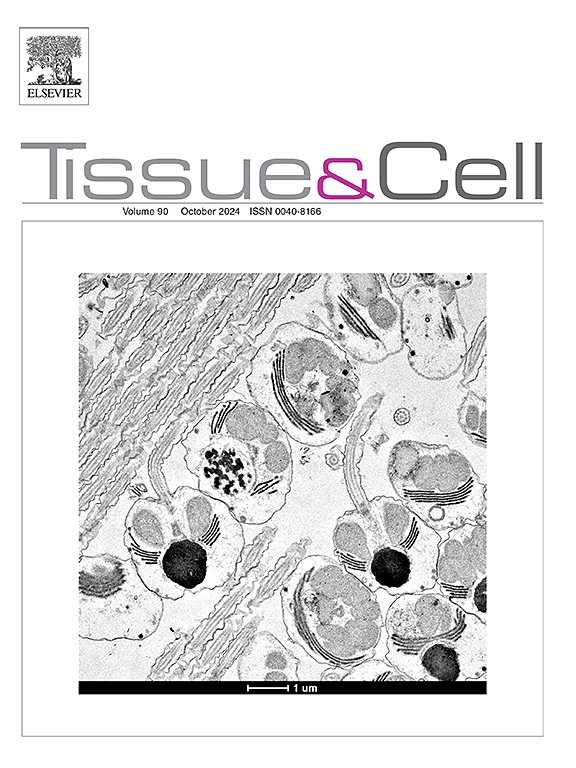Vitamin D alleviates chronic stress-induced testicular steroidogenesis disruption in Wistar rats
IF 2.7
4区 生物学
Q1 ANATOMY & MORPHOLOGY
引用次数: 0
Abstract
Stress is associated with various health issues. Research has highlighted the relationship between chronic stress and male reproductive health. One of the primary mechanisms underlying stress-induced male reproductive dysfunction is impaired steroidogenesis. In the present study, we validated a chronic unpredictable stress (CUS) model and investigated testicular dysfunction in CUS rats. The CUS paradigm involved exposing rats to a variety of stressors daily for 8 weeks. Vitamin D (10 µg/kg/twice a week, p.o) was administered to CUS rats starting 2 weeks after the onset of stress exposure and continued until the end of study. The stress in rats was confirmed by the occurrence of anxiety and depressive-like behaviours through elevated plus-maze test & novelty-suppressed feeding test and rise in serum corticosterone levels. Testicular dysfunction in CUS rats was assessed via serum gonadotropins, testosterone, cytokines, oxidative stress, and testis-epididymis-sperm morphology. The reduction in steroidogenesis was confirmed via immunohistochemical analysis of 17β-hydroxysteroid dehydrogenase-3 (17β-HSD3), steroidogenic acute regulatory gene (StAR) and vitamin D receptor (VDR) expression. Further, we studied the role of vitamin D in alleviating stress-induced testicular damage and the potential mechanisms underlying steroidogenic alterations in CUS rats. Notably, vitamin D treatment prevented CUS-induced decline in testicular 17β-HSD3, StAR and VDR expression. Moreover, vitamin D ameliorated the CUS-induced reduction in serum testosterone levels. Histological assessment revealed that vitamin D prevented CUS-induced damage in sperm, testis and epididymis morphology. In conclusion, our findings suggest that CUS exposure induces testicular dysfunction, which can be prevented by vitamin D, potentially through the regulation of steroidogenic pathways.
维生素D减轻Wistar大鼠慢性应激性睾丸甾体生成破坏
压力与各种健康问题有关。研究强调了慢性压力与男性生殖健康之间的关系。应激性男性生殖功能障碍的主要机制之一是激素生成受损。在本研究中,我们验证了慢性不可预测应激(CUS)模型,并研究了CUS大鼠睾丸功能障碍。CUS范式涉及将大鼠暴露于各种压力源,持续8周。从应激暴露开始2周后开始给CUS大鼠服用维生素D(10 µg/kg/ 2次,每周,p.o),一直持续到研究结束。通过升高的+迷宫测试,大鼠焦虑和抑郁样行为的发生证实了应激的存在;新奇性抑制喂养试验和血清皮质酮水平升高。通过血清促性腺激素、睾酮、细胞因子、氧化应激和睾丸-附睾-精子形态评估CUS大鼠睾丸功能障碍。通过免疫组化分析17β-羟基类固醇脱氢酶-3 (17β-HSD3)、类固醇急性调节基因(StAR)和维生素D受体(VDR)的表达,证实了类固醇生成的减少。进一步,我们研究了维生素D在缓解应激性睾丸损伤中的作用,以及在CUS大鼠中类固醇生成改变的潜在机制。值得注意的是,维生素D治疗可以防止cu诱导的睾丸17β-HSD3、StAR和VDR表达的下降。此外,维生素D改善了cu诱导的血清睾酮水平降低。组织学评价显示,维生素D可预防cu诱导的精子、睾丸和附睾形态损伤。总之,我们的研究结果表明,暴露于CUS会导致睾丸功能障碍,而维生素D可能通过调节类固醇生成途径来预防睾丸功能障碍。
本文章由计算机程序翻译,如有差异,请以英文原文为准。
求助全文
约1分钟内获得全文
求助全文
来源期刊

Tissue & cell
医学-解剖学与形态学
CiteScore
3.90
自引率
0.00%
发文量
234
期刊介绍:
Tissue and Cell is devoted to original research on the organization of cells, subcellular and extracellular components at all levels, including the grouping and interrelations of cells in tissues and organs. The journal encourages submission of ultrastructural studies that provide novel insights into structure, function and physiology of cells and tissues, in health and disease. Bioengineering and stem cells studies focused on the description of morphological and/or histological data are also welcomed.
Studies investigating the effect of compounds and/or substances on structure of cells and tissues are generally outside the scope of this journal. For consideration, studies should contain a clear rationale on the use of (a) given substance(s), have a compelling morphological and structural focus and present novel incremental findings from previous literature.
 求助内容:
求助内容: 应助结果提醒方式:
应助结果提醒方式:


